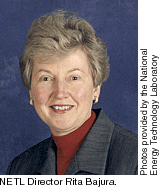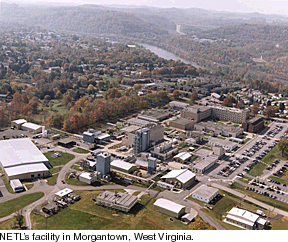
NETL nets public-private partnerships for DOE’s
EM program
The newest Department of Energy national laboratory has years of experience partnering with the private sector in energy programs. That experience is reaping benefits for the department’s Environmental Management program through the Office of Science and Technology. From its facilities in Pittsburgh, Pennsylvania and Morgantown, West Virginia, NETL manages about 600 worldwide projects—most in the United States—and has about 1,100 employees. Its predecessor organization was involved in coal and natural gas research for the past 50 years. Since 1992, it has also supported DOE’s Office of Environmental Management (EM). It is not contractor-operated like other national labs but is a government-owned, government-operated facility.
Since it was formed in 1997, the organization—then called the Federal Energy Technology Center (FETC)—has been managed by Rita Bajura, a federal executive with more than 20 years of experience in joint government-industry projects. "We have a 50-year history of partnering with the private sector to create technology solutions," Bajura said. "Thus, NETL, FETC, and other precursor organizations have always been outwardly focused. Our heritage is very different from the rest of DOE, which traces its heritage to the Atomic Energy Commission—and, of necessity, had an inward focus."
Under Bajura’s leadership, NETL has successfully applied its well-developed public-private partnering capabilities to solving problems in the EM program in the same way it has effectively conducted energy programs. The lab develops EM technologies not in its own facilities, but through innovative contracting with the private sector. "I believe our strengths complement the strengths of other parts of DOE," Bajura said, "and the entire EM program benefits." NETL uses the entire R&D resource base of the United States, including industry, universities, other national laboratories, and other organizations. It has the authority to enter into many types of contracts and assistance agreements on behalf of DOE—even to negotiate patent and data rights, which are important to private industry’s involvement. Managing EM science, technology Many successes One such success story in the D&D focus area is the Pipe Explorer™ Surveying System developed by Science and Engineering Associates (OST/TMS ID 74, see Initiatives February 1996, February 1997, and Winter 1998). It uses air pressure to guide a tubular membrane through pipes and around elbows to characterize radiological contamination inside pipes. It can travel hundreds of feet towing a video camera, a characterization sensor, or pipe-locating equipment. It has saved DOE millions of dollars. Another success story is the Surface Acoustic Wave/Gas Chromatography System for Trace Vapor Analysis (OST/TMS ID 282, see Initiatives August 1996 and Spring 2000), a low-cost sensor that detects and analyzes vapors. Electronic Sensor Technology markets the product to government and private users. In addition to applications that have saved millions for DOE, it is being used by the Defense Department to detect contraband. Still another development project that has broad application within the DOE nuclear complex is called Nondestructive Waste Assay Using Gamma-Ray Active and Passive Computed Tomography (OST/TMS ID 2123, see Initiatives August 1996, February 1997, Spring 1999, and Summer 1999), which resulted from a contract between Bio-Imaging Research, Inc. and what was then the Mixed Waste Focus Area. Leveraging dollars Once those opportunities are identified, there are several mechanisms for establishing partnerships, commercializing technology, or transferring inventions to the private sector. One is the Contract/Financial Assistance Agreement, which may offer federal development dollars. Another is the Licensing Agreement, in which the private party pays royalties to the government. Still another is the Contributed Funds-In Agreement, which enables work at NETL for a nonfederal sponsor. Each option offers advantages under certain circumstances, so it’s important to choose the right partnering vehicle. Since 1992, EM has invested more than a quarter of a billion dollars in projects through Industry and University Programs. "The question that Congress always asks," said Bajura, "is, ‘What is DOE’s return on this investment?’ We believe DOE could save $800 million to $2.4 billion from deploying 15 of the most successful technologies in the program. These have all been demonstrated or are in the demonstration stage." Lessons learned Another lesson from eight years of EM involvement is that a new technology needs to be a whole lot better than the baseline technology or fill a definite gap. "Modest improvements are not worth the risk of deployment," she said. Also, relationships matter, according to Bajura. "Pick up the telephone," she advised. "Relationships help build a commitment from the site personnel to deploy the technology product." The final lesson NETL and its predecessor organizations have learned is simply this: there are many positive benefits of partnering for both DOE and the U.S. economy. Environmental businesses constitute a $181 billion industry that employs 1.3 million Americans, and DOE’s environmental programs are a key part of it. Bajura believes, "Inviting the private sector to compete in the DOE market is a strategy with extensive benefits."
|
 When federal resources are combined with the profit
motive, great things can happen. Many activities can benefit from the synergy of
government-industry partnerships. DOE’s
When federal resources are combined with the profit
motive, great things can happen. Many activities can benefit from the synergy of
government-industry partnerships. DOE’s  Designation
as a national laboratory in December 1999 was a positive development—a form of
recognition that its work, for years, has been national in scope. Perhaps more
importantly, it gave the prestigious research organization a leg up in competing for
funding, both from within DOE and from outside the department.
Designation
as a national laboratory in December 1999 was a positive development—a form of
recognition that its work, for years, has been national in scope. Perhaps more
importantly, it gave the prestigious research organization a leg up in competing for
funding, both from within DOE and from outside the department.